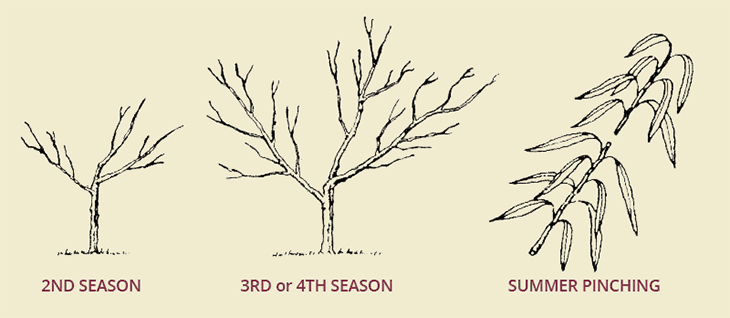Contents
Getting a good harvest of peaches directly depends on the quality of tree care. The more complete and timely such events are carried out, the better the result will be. One of these procedures is spring and summer peach pruning. It helps not only to form a full-fledged tree, but also to extend the period of its active fruiting.
Purposes of peach tree pruning in spring and summer
The task of the gardener is not only to grow a peach tree, but also to get good and regular harvests from it. It is for this purpose that all types of pruning are made. With the help of this procedure, the crown of a young tree is formed, the most convenient for working with it.
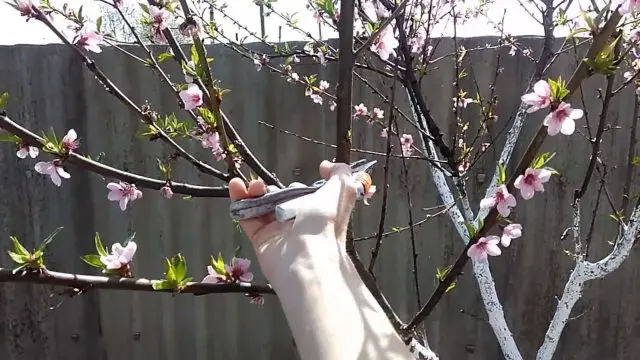
Pruning is carried out in sanitary areas, to improve the condition of the tree, rejuvenate and normalize the crop. Such events are held strictly at a certain time and according to a certain scheme.
Types of trimming
The peach is a fairly fast growing tree. If you do not trim it, the crown will thicken very quickly, and the fruits will be crushed. To bring the tree in order, several basic types of peach pruning are used.
- Sanitary. It is carried out annually to maintain the tree in a healthy state.
- Formative. It is done during the first years after planting a seedling to form the crown of a tree in a certain way.
- Anti-aging. It is produced in order to rejuvenate the tree and prolong its life and active fruiting.
- Recovery. It is carried out a year after anti-aging. Allows you to re-form the skeleton of the tree.
- contour. It is done to keep the crown in the required dimensions.
As a rule, different types of peach pruning are combined to achieve the best result.
peach pruning timing
All main types of pruning are usually carried out in the spring, choosing for this a period when the buds are just beginning to swell on the tree. It is difficult to specify a specific period for carrying out this procedure, since it strongly depends on the climatic features of the growing area. In the southern regions, peach pruning time usually falls in March, in more northern regions – in April. During this period, they carry out sanitary cleaning of trees after winter, form the crown of young seedlings, and rejuvenate old trees.
Peach pruning in the summer includes removing broken and damaged branches, as well as disease-damaged shoots. It is produced in June. In addition to sanitary cleaning, improperly growing, crossing, thickening branches, top shoots are removed. They also shorten the annual growth on which the crop ripens. This is due to the fact that the peach sets 100% of the flower ovaries. If the crop is not rationed, the tree literally does not have enough nutrients to grow the entire number of fruits. The harvest in this case will be plentiful, but very small. To improve its quality, annual shoots are pruned, thereby reducing the number of ovaries, but increasing the quality of ripening peaches.
Autumn peach pruning is done only for sanitary purposes. In the southern regions, at this time, too long annual growth is shortened, and basal shoots are also cut out. In regions with a cool climate in autumn, it is recommended to limit yourself to sanitary pruning so as not to weaken the plant before wintering.
Is it possible to cut a peach in August
Due to the intensive growth of annual shoots, peach often has to be cut 2-3 times during the summer, including in August. If such a procedure is not carried out, the trees begin to hurt, the flow of gum intensifies. The crop is sharply smaller, and after a few years the tree may completely stop bearing fruit.
Peach Tree Pruning Schemes
The peach pruning scheme in spring depends on the region of its growth. In the south, they are most often formed in the form of a bowl, in the central regions – a bush, and in areas with adverse weather conditions – in a slate form. In addition, peach is formed according to the principle of a grape bush, as well as in the form of a column (columnar varieties).
Shaping the crown of a peach with a bowl is used most often and is considered the most suitable method for growing it. This form allows you to work with the crown without resorting to the help of a stepladder. Uniform illumination of the inner space of the tree contributes to good yields, while air exchange is not disturbed inside the crown. A bowl is formed from 3-4 skeletal branches on a low (40-50 cm) stem. The further north a peach is grown, the lower the bole is made.
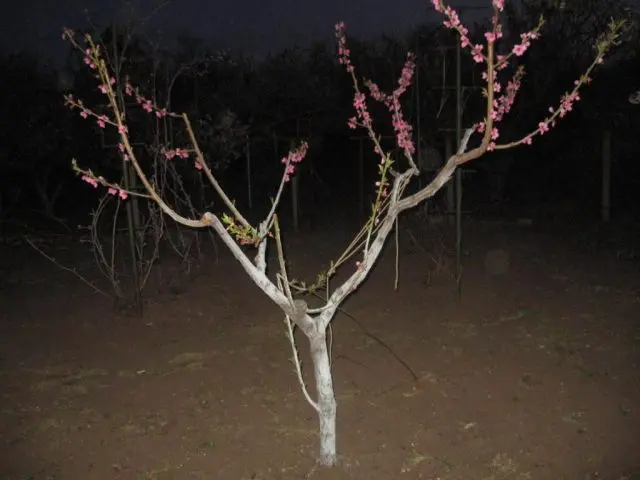
In the middle lane, the formation of a peach in a bush form is considered optimal. To do this, leave a few of the lowest side shoots, which are cut short. The central conductor is also cut into a ring. In the future, 6-8 equivalent ones are selected from young shoots, which will form the basis of the bush. The rest of the shoots are removed. Pruning achieve uniform development of all shoots, as well as maintaining a spherical shape.
The slate form is extreme and is used when growing peach in areas not intended for the cultivation of this crop. As a rule, with this formation, the seedling is planted at an angle of 45 °, and the tree itself is formed from 2 horizontal shoots. This form allows you to completely cover the peach for the winter.
The formation and pruning of the peach crown in the form of a grape bush can be carried out if the rounded crown causes inconvenience to the gardener. To form a crown according to this scheme, several multidirectional shoots are selected that have large angles of departure and are at least 20 cm apart from each other. The rest, including the central conductor, are cut into a ring.
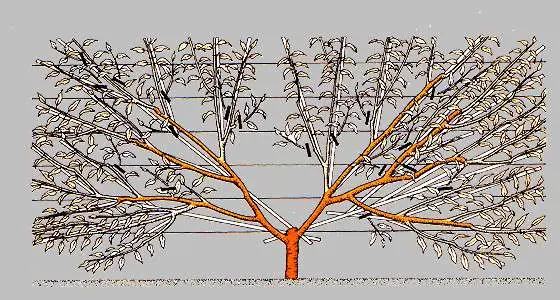
The columnar peach is the easiest to cut. Pruning of such varieties is reduced only to sanitary cleaning, as well as to cutting out shoots that protrude beyond the size of the crown.
Correct peach pruning depending on the age of the trees
Peach pruning techniques in the spring vary, depending on the age of the tree. During the first few years, the skeleton of the tree is formed, the main branches are laid. In the future, excess and improperly growing branches are removed, the harvest is normalized, and sanitary cleaning is carried out.
How to prune a young peach
After planting in a permanent place, the peach seedling is cut at a height of about 60 cm. 2-3 skeletal branches are left on the stem, which are cut to 3 buds. Above them, up to the cut of the central conductor, about 10 healthy kidneys should remain. All other shoots are cut into a ring.
In the second year of life, the formation of the lower tier continues. Annual growths are shortened to 60-65 cm. At a distance of 30-35 cm above the lower tier of skeletal branches, two multidirectional powerful branches are selected, which will be skeletal. They are cut so that they are 10-15 cm shorter than the lower ones. The central conductor is cut just above the level of the upper side branch.
In the spring of 3 years of life, all the necessary shoots on skeletal branches are shortened to 0,4 m. By autumn, a full-fledged tree is formed. On it, you need to remove fattening shoots, tops and branches growing deep into the crown.

At the age of 4, the formation of a peach tree is considered complete. In the spring, young shoots are shortened to 5 flower buds, and branches that grow above the required level and go beyond the size of the crown are also cut off.
Rules for pruning fruit trees
Pruning of adult fruit-bearing peaches is carried out for sanitary purposes, as well as for crop rationing. For this, 1-2 are left on underdeveloped shoots, and up to 5 flower buds on others. Pruning is carried out on the selected growth bud, thereby correcting the direction of the future growth of the branch. It should be directed to the side (not up!), And also should not intersect with other shoots in perspective.
The crown of an adult plant must be maintained at the same height, avoiding its distortion. If the shoots are taller from any edge of the bowl, then this part will receive more sunlight, and the uniformity of ripening will be disturbed.
How to rejuvenate a peach tree
A peach tree can bear fruit for up to 10 years. Then it should be rejuvenated. Over the course of several years, part of the old wood is gradually removed, while growth is transferred to new skeletal branches, the age of which does not exceed 2-3 years. In addition, all shoots growing down are shortened.
Pruning an old peach
If a peach has not been pruned for a long time, you can bring it back to normal and restore its fruiting by pruning. To do this, do the following:
- Reduce the crown to 2,5-3 m. It is necessary to cut out all the fattening shoots growing up. So that the crown does not turn out to be one-sided, you can transfer some of these branches to lateral growth.
- Lighten the crown. To do this, it is necessary to remove thickening, rubbing against each other, branches directed inward, as well as tops.
- Clear the tree. All dry, diseased, broken branches must be completely removed.
- Rejuvenate a peach by removing some of the old skeletal branches.
How to prune a peach for fruiting
Pruning a peach tree for fruiting is used to bring the crop into line with the size of the tree. Such a measure normalizes the number of future fruits and avoids overloading the tree. Pruning for fruiting is done as follows.
Fruit links are formed from lateral shoots, observing the necessary intervals:
Shoot length, cm | Interval, cm |
25 – 50 | 10 |
50 – 70 | 15 – 20 |
Over 70 | 25 – 30 |
In the intervals between shoots, replacement knots are formed – the same side shoots, only cut to 2 growth buds. The next year, the same fruit link will be formed from them, and the fruiting shoot will need to be removed. All other shoots in the intervals are to be removed.
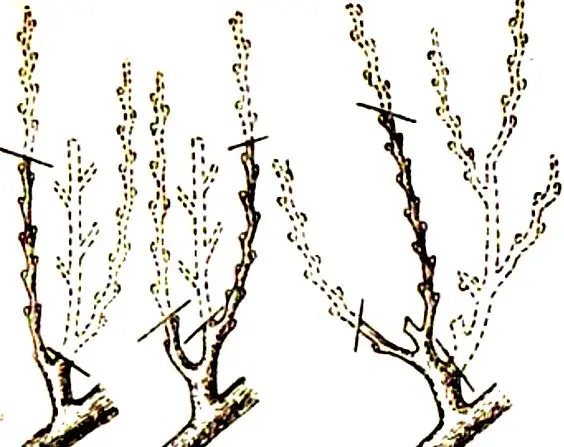
To normalize the load on the tree, the number of fruit links is brought into line with the productivity of the peach variety. For varieties with low productivity (Success, Molodyozhny, Zlatogor), the number of fruiting shoots should be from 150 to 200, for medium-yielding ones (Golden Moscow, Kudesnik, Kremlevskiy) – from 90 to 130, for high-yielding peaches (Flamingo, Krasnoshchekiy, Krymchak) 40- 80 pcs.
After flowering and the formation of fruit ovaries, the final rationing of the fruit load is carried out. At the same time, weak shoots are removed first of all.
How to prune a peach after fruiting
Peach pruning after harvest is done for hygienic purposes, to keep the tree clean. All dried, broken or damaged branches, wen and tops that have not been removed earlier are removed. It is also necessary to remove shoots that have signs of disease or are damaged by pests. It is impossible to subject a peach to strong pruning, this can greatly weaken it before wintering. It is better to carry out this procedure in September or early October. Later dates are undesirable.
A useful video for beginners on how to prune a peach in spring is at the link below.
Peach care after pruning
Pruning is like a surgical operation, so it is very important to do it accurately and on time. And also it is necessary to use only well-sharpened and disinfected tools. Smooth cuts heal much faster, and the entire period of rehabilitation of the tree will take much less time.
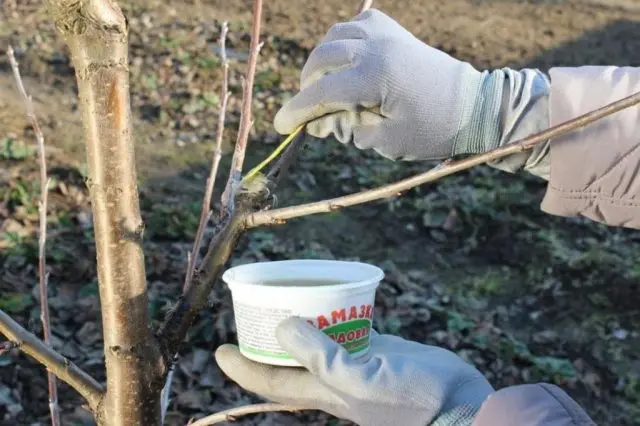
After the pruning is completed, the peach needs care. All sections must be treated with a 3% solution of copper sulfate to protect against infection, and then covered with garden putty. Large sections can also be covered with natural-based oil paint. Many gardeners do not recommend using garden pitch, because the knots under it can rot.
Conclusion
Peach pruning is a mandatory procedure that should be done annually. Without it, the yield will drop sharply, the fruits will be crushed, and instead of fruiting, the tree will begin to grow up uncontrollably, wasting energy on forcing shoots. There is no need to be afraid of pruning. It is enough to cut the peach correctly once with an experienced mentor, and in the future the procedure will not cause difficulties.










